Integrated Disease Management Wilt of Lentil Caused by Fusarium oxysporum f. sp. Lentis
Keywords:
Biocontrol agent, Fusarium, Lentil, fungicidesAbstract
Effect of chemical, bio-agents and Rhizobium was tested alone and in combination to see their individual as well as combined effect on wilt disease management in pot under net house conditions. Eighteen treatments were under taken in this study, among them highest per cent disease control (70.89%) was recorded with Rhizobium (ST)+ Carbendazim.(ST)+ Pseudomonas sp.(SoilT) followed by Rhizobium(ST)+Carbendazim.(ST)+ Bacillus subtilis (SoilT) (67.05), Rhizobium (ST)+Carbendazim. (ST)+T.h. (64.64%), Rhizobium(ST) + soilT T.harzianum (63.36%), Rhizobium(ST) + Carbendazim. (ST) (59.47%), Rhizobium(ST) + Pseudomonas fluorescens (SoilT) (58.94%), Rhizobium(ST)+Bacillus subtilis (SoilT) (57.12%), Rhizobium(ST) + T.harzianum(SoilT) (56.66%), Rhizobium(ST) + T.harzianum(ST) (56.41%), Carbendazim.(ST) (52.48%), Pseudomonas fluorescens (SoilT) (49.92%), Bacillus subtilis (SoilT)(46.24%), T. harzianum (SoilT) (43.52%), Pseudomonas fluorescens (ST) (42.08%), Bacillus subtilis (ST) (39.04%), T. harzianum(ST) (35.89%) and Rhizobium(ST) (17.58%) as compared to untreated pots during 2016-17.
References
Abraham, R. “ Lentil (Lens Culinaris Medikus) Current Status and Future Prospect of Production in Ethiopia” Adv. Plants Agric Res.2 (2): 00040, 2015.
Ahmad, D. K. Sinha and K. M. Singh, “Economic Analysis of Production and Instability of Lentil in Major Lentil Growing States of India” Int. J. Pure App. Bio.sci. 6 (1): 593-598, 2018.
Ali, M. and Mishra, J. P, “Importance, Area and Production. In: Technology for Production of Winter Pulse”. Bubl. IIPR. pp. 6 – 9, 2000.
Arasu, M. V., Esmail, G. A., Al-Dhabi, N. A., & Ponmurugan, K.” Managing Pests and Diseases of Grain Legumes with Secondary Metabolites from Actinomycetes. In Plant Growth Promoting Actinobacteria” Springer Singapore pp. 83-98, 2016.
Ram, H. and Pandey, R. N.” Evaluation of biocontrol agents and fungicides for the management of black root rot of chickpea incited by Fusarium solani(Mart) Sacc.” Indian Phytopathology 64: 32-33, 2011.
Shahiduzzaman, M. “Efficacy of fungicides and botanicals in controlling foot and root rot of lentil” Bangladesh Journal of Agricultural Research, 40(4), 711-715, 2016.
Singh, Sushil Kumar, Kumar, A., Singh, Bhanu Pratap., Yadav, J. K. and Dubey, K. “Integrated management of lentil wilt caused by Fusarium oxysporum f. sp. Lentis” Int. J. Curr. Microbiol. App. Sc. 6(10): 1319-1322, 2017.
Sinha, R.K.P., and Sinha, B.B.P, “Effect of potash, botanicals and fungicides against wilt disease complex in lentil” Annals of Plant Protection Sciences 12 (2): 454-455, 2004.
Srivastava, Mukesh, Gurha, S .N. and Narain, Udit. “Prospects of integrated management of root diseases in pulse crop. Souvenir of National Symposium on Important Plant diseases of North -Eastern India and their Management” held at Department of Plant Pathology N. D. University of Agriculture &Technology, Kumarganj, Faizabad from 6-7, December, 2000. Pp 14-15, 2000.
Downloads
Published
How to Cite
Issue
Section
License

This work is licensed under a Creative Commons Attribution 4.0 International License.
Authors contributing to this journal agree to publish their articles under the Creative Commons Attribution 4.0 International License, allowing third parties to share their work (copy, distribute, transmit) and to adapt it, under the condition that the authors are given credit and that in the event of reuse or distribution, the terms of this license are made clear.







